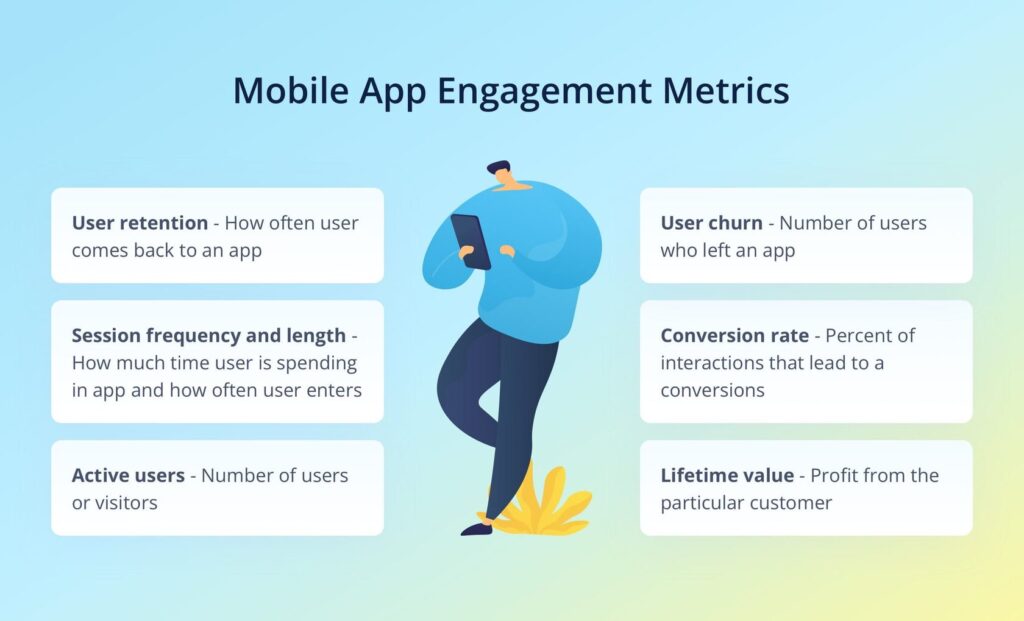Several tens of thousands of new products appear every month in the App Store and the Play Market. At the same time, statistics show that users can have up to a hundred apps on their devices but regularly use only a third of them (at best). Whether you launch a new app or look to spice up an old project that doesn’t work properly, you need to know how to get as many users as possible and improve app engagement. After all, creating and in-app advertising is only half the battle; the next task is to retain existing customers and expand the base.
Given the ever-increasing competition, the task might seem challenging. Luckily, there are proven techniques and methods to help you carve out your niche and keep your audience interested. In this article, we’ll take a closer look at what user engagement is in terms of mobile apps, which engagement strategies are most effective, and which metrics will help you track your work effectiveness. After reading, you will be able to identify weaknesses in your work and strengthen them for better performance.
Table of Contents
What Is App Engagement?
The term “app user engagement” refers to user interaction with a mobile application. In other words, this indicator demonstrates the value of your product through the frequency, duration, and quality of its use. Don’t confuse it with regular quantitative usage, as engagement is more than that.
By being involved, clients realize the importance of the app in performing their home and work tasks over a long period. The higher the in-app engagement score, the more app download and revenue users can bring to you. That is why you need to regularly monitor and measure the level of engagement to identify problems and respond to them on time.
Features to Keep Users Engaged
There are many effective ways to increase mobile app engagement. Here are just a few of the steps you can take.
Think over your mission
With the help of a creative story about your mission, worldview, and values, you can get closer to your target audience. That is why it is extremely important to study potential clients carefully, for example, as part of ASO keyword research.
Today, many people try to pursue mindful consumption. Generation Z representatives are the most active in this direction. As they make up 40% of all users of mobile devices and spend more on apps than other generations, you should work with them properly. Let them know you are on the same page with them.
Gamify your product
Many classic app features can be made more “catching” by introducing game-like features. Give out rewards, accrue points, show progress, and offer badges. As the experience of Duolingo, a popular language learning service, shows, these mechanics not only enthrall every user, engage the audience, or motivate people to continue using the product further but also stimulate referrals, which is very important for the customer base growth.
Simplify onboarding
Confirmed fact: The most significant drop in the number of users occurs during the onboarding in app stage. Each additional step increases churn by an average of 20%. Use onboarding training when you really need it, for example, when you offer unique features or target inexperienced customers. Minimize guides and instructions and instead show the app’s importance and value. Also, make it easy to sign up, agree to policies, and make initial settings.
Don’t forget socialization
Offer your users the opportunity to share progress, connect with like-minded people, and follow the leaderboards. Forums, lists of winners, and quick access to social networks add a playful element to the standard app mechanics and contribute to a longer use. Competitions and other real-time features to keep users engaged set specific goals that motivate people to complete tasks regularly.
Use chatbots
Quick access to support and getting answers to questions faster are effective engagement strategies examples. Nowadays, time is a critical resource. Users’ problems and pains should be resolved as quickly as possible, and artificial intelligence is fully responsible for this task. Compared to human support, chatbots can increase engagement by 400%.
Mobile App Engagement Metrics
Before you dive into materials on how to increase mobile app engagement, it’s important to understand how and why to measure it. The point is that you need to be clear about whether your product performs well, whether your customer base grows, whether your app does what it was designed to do, and more.
Measuring the level of engagement since launch allows you to evaluate both positive and negative changes in the quality of the product use. Moreover, the engagement rate directly affects many other key metrics like user retention level and app conversion rate.

Metrics
Engagement is a rather complex and multi-level term, so the answer to the question “What are engagement metrics?” might be complicated. Understanding the notion and the desired engagement level might vary for each product and audience. You can evaluate user behavior and the quality of interaction with the app using the following metrics:
- User retention
Developers and marketers often compare engagement vs retention. We can say that these concepts are pretty interchangeable and show you how attractive your product is to customers in the long run.
- Active users
Typically, visitor data is analyzed per day (DAU) and month (MAU); less often, developers check users per week (WAU). Active users are those who regularly perform a key action within a certain period.
- User churn
This metric shows the number of users who abandon the app. They can do it because the product does not meet their expectations or there are some issues inside it.
- Session frequency and length
You can measure retention and engagement by how much time users spend on your app and how often they launch it. If the time spent and the number of launches decreases, it indicates problems. You can learn more about how to measure retention on our blog.
- Conversion rate
The concept of conversion can vary: from installing an advertised app to switching to a paid subscription. If your download rates aren’t high enough, check out our article “How to Increase App Downloads.” If users do not switch to new levels, you need to work on the product’s content.
- Lifetime value
This metric is necessary to evaluate how much costs particular user spends on your service. It shows the whole revenue an user generates. The higher it is, the better you work with this user.
App Engagement Strategy Tips
Looking for more ways to improve your mobile app engagement campaigns? Here are some more expert tips:
- Personalize the experience. You can address customers by name, make unique offers, send personalized push notifications, and more.
- Motivate to generate content (UGC). It builds trust in the brand, makes the audience more loyal, and promotes word-of-mouth marketing.
- Send out behavioral emails. Reinforce the app experience with emails with tips, tutorials, surveys, and more.
- Upsell and re-engage clients. Existing users are already interested in your product and its extra features. The cost of their re-engagement is much lower than the price of attracting new customers.
- Improve the app regularly. Test and optimize the product and implement new features to keep users interested. The app should change and evolve along with the client base and global trends.
Work on Engaging Users Non-Stop
The exact list of tactics and steps to engage users differs depending on the characteristics of a particular app and target audience. To really make your product sticky, you need to know what works for your users and what doesn’t. It’s important to be able to offer experiences that will help you create a viable product that has value for people in the long run.
Keeping users’ attention and constantly working on engagement is not easy. Nevertheless, it is one of the most essential aspects, given the daily growing competition in the mobile product market. It is crucial to work on multiple fronts and engage users inside and outside the app, for instance, through social media, email, forums, and so on.
You can track the effectiveness of your actions using the described metrics. Moreover, such work should not stop when the desired indicators are achieved. You need to constantly improve your strategy to keep people interested. Use the Asolytics experts’ recommendations to launch a new unique app or revive an old project that has begun to lose ground.




